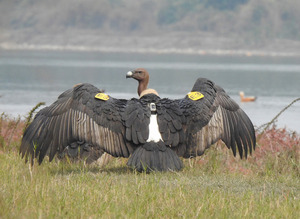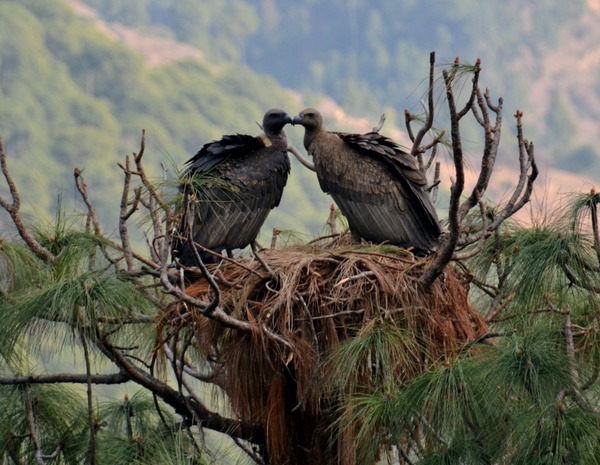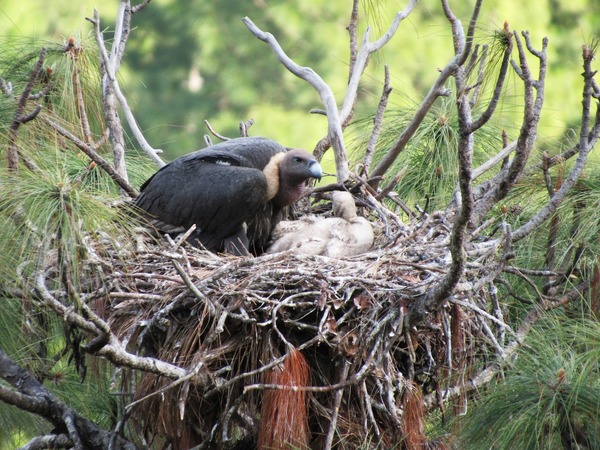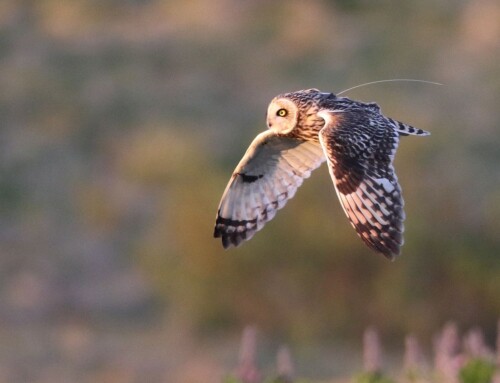 LINKED PAPER
LINKED PAPER
Population and Productivity of the Critically Endangered White-rumped Vulture (Gyps bengalensis) in the Argha Important Bird and Biodiversity Area, Nepal. Bhusal, K.P., Joshi, A.B., Rana, D.B., Thakuri, D.C., McClure C.J.W. 2023 Journal of Raptor Research. DOI: 10.3356/JRR-22-61 VIEW
Finally, some good news for vultures – two colonies of nesting White-rumped Vultures (Gyps bengalensis) demonstrated stable reproductive rates over an 11-year study in an Important Bird and Biodiversity Area of central-western Nepal.
From 2002 to 2011 White-rumped Vultures suffered a 91% population decline in Nepal, going from a species that, in the 1980s, was considered the most abundant large raptor in the world to critically endangered in less than 10 years. Globally, 75% of vulture species are listed as either endangered or critically endangered by the International Union for the Conservation of Nature (IUCN). These declines are the direct result of human actions including the use of an anti-inflammatory drug for cattle called diclofenac, which causes kidney failure in vultures, killing them en masse due to their communal feeding behavior. The swiftness of these population declines resulted in a domino effect of consequences, such as the spread of diseases and their mammalian vectors. Communities across the world rallied to ban diclofenac and establish vulture conservation programs. This support included the creation of Vulture Safe Zones in 2009, defined as “an area surrounding one or more wild vulture nesting colonies, large enough to encompass the mean foraging range completely free of diclofenac use”. Lead author of the paper, Krishna Prasad Bhusal, with Bird Conservation Nepal, says these zones, combined with community engagement, have “definitely supported this species’ conservation”.

Figure 1 A pair of critically endangered White-rumped Vultures in the nest. They use large and tall Pinus trees for nesting in Argha IBA, Arghakhanchi © Krishna Prasad Bhusal.
The Argha Important Bird and Biodiversity Area was designated a globally significant landscape in 2015 for the sake of threatened birds, including two important breeding colonies of White-rumped Vultures (Bhusal et al. 2020). Researchers visited the colonies three times per breeding season between 2010 and 2021 to monitor nesting success, observe nest site characteristics, and improve our understanding of population trends. The results were positive. The proof was in the productivity, referring to the number of nestling vultures that successfully fledged per occupied nest. Over the course of the study, the number of occupied nests increased, and productivity appeared stable – an important uplift in fortunes for the species, confirming the efficacy of vulture conservation initiatives established in Nepal!
Bhusal and his coauthors mention several other interesting findings in their paper — nearly all of the vulture pairs nested in chir pines (Pinus roxburghii), a tree native to the Himalayas, and of clear importance to nesting vultures. Additionally, in 2021 they saw the highest number of occupied nests during their study with a whopping 24.

Figure 2 Adult with newly hatched chick on the nest in Argha IBA, Arghakhanchi © Krishna Prasad Bhusal.
Together, the outcomes of this study demonstrate the capacity of fervent and localized conservation to turn things around. Bhusal says people living near the study site are “motivated and proactive in contributing to the protection of vultures in the area,” and participate annually in International Vulture Awareness Day. He hopes to study the impact of climate change and other anthropogenic influences on breeding activities of White-rumped Vultures and continue monitoring the two colonies. Ideally, this study will be replicated elsewhere. Conservationists agree that we must expand our collective knowledge of endangered vultures and the ecosystems that will allow them to fill the skies once again.
References
Bhusal, K., Pandey, M., Magar, T.G. 2020. Diversity and Status of Birds in Argha Important Bird and Biodiversity Area, Western Midhill of Nepal. Danphe 29:1-11. VIEW
Image credit
Top right: Monitoring survival and movement of a White-rumped Vulture with satellite and wing tags © Ankit Bilash Joshi.
If you want to write about your research in #theBOUblog, then please see here.




